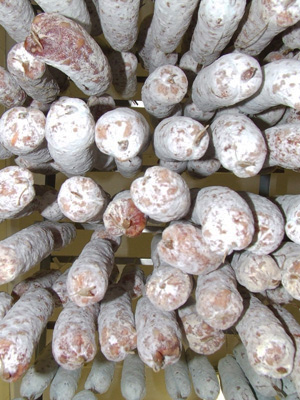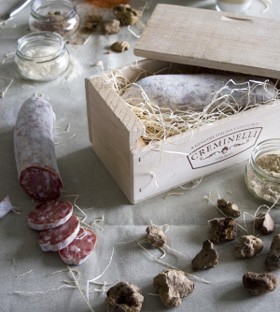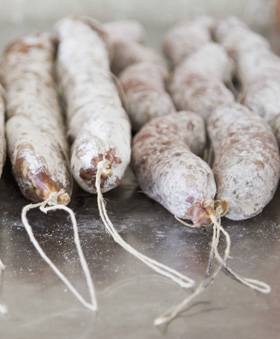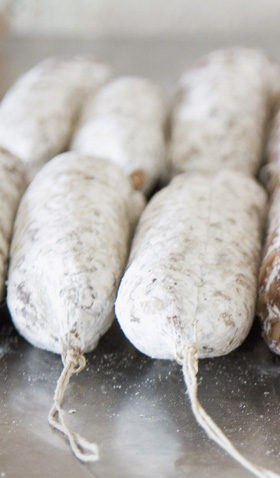 |

| |

Photographed from below: handmade salami hanging from the rack. |
| WHAT IT IS: Authentic, handmade Italian salami and sausages. |
| WHY IT’S DIFFERENT: Recipes and techniques dating back hundreds of years, made in Seattle by a master artisan from Italy. |
WHY WE LOVE IT: The pork is exceptional and the recipes and craftsmanship are enough to make any meat lover ecstatic. |
| WHERE TO BUY IT: Buy Online Here. |
|
|
 |

Creminelli Fine Meat
Page 2:
Hard Italian Salami
This is Page 2 of a three-page article. Click on the black links below to visit other pages.
INDEX OF REVIEW
MORE TO DISCOVER
|
Salami Versus Salame Versus Sausage
In Italian, one aged, salted, dry-cured, spiced pork sausage is un salame (SAH-la-meh) Two or more are salami (SAH-la-mee). Only in America is a single aged, cured sausage called a salami. The word comes from the Vulgar Latin, salamen, from the Latin salare, to salt. But Cristiano Creminelli goes with the flow and uses the Americanized terms; he’ll sell you a salami.
As long as we’re on the topic, sausages are fresh—raw and unaged. The Italian word for sausage is salsiccia, plural salsicce (pronounced sahl-SEET-chyah and sahl-SEET-chay, but no one uses those words in the U.S., except perhaps the guys in the Pork Store in “The Sopranos”). Examples in addition to Italian sausage include bangers, bratwurst and breakfast sausage.
There are also smoked sausages which are cooked and ready to heat and eat. Hot dogs, kielbasa and generic smoked sausage are examples. Now that you know the fundamental differences, let’s take a look at Creminelli salami.
|
|

Truffle Salami, our favorite, shown here with white Oregon truffles. See our Truffle Glossary for more information about truffles.
|
Creminelli Salami
The one thing all the salami have in common is the quality of the meat: the fine pork that is apparent in every bite. When you see the prices, remember that you’re not just paying for the craftsmanship, but for truly superior meat. That being said, you’ll need good teeth to take on these salami; delicious as they are, they are chewy, in the hard, dry Italian style. They are also picturesque, made the artisan way in natural pork casing, which is peeled off before the meat is eaten. Just don’t make a point of this to your guests, who will admire the beautiful appearance of the salami.
Salami Barolo may be hard and chewy, but liquid pockets of fat squirt in your mouth in the most delightful way. This style of sausage comes from Piedmont, where Barolo wine is made. You won’t really taste the wine that is added to the sausage, but the seasoning is impeccable, with a lovely tang.
Salami Cacciatore translates to “hunter’s salami,” so-called because these are smaller salamis, three to four inches long, and easily portable. The hunter would cut off thick slices, which is how the salami is served today. The taste is meatier and more flavorful than Salami Barolo (juniper berry is used as a seasoning, which adds fruitiness), with more salt.
Salami Casalingo, also called salami di casa, translates as “the salami of the house,” after the Italian tradition of each household making its own salami. This is the Creminelli’s salami di casa; while they call it “sweetness and simplicity,” we found it more highly seasoned than Salami Cacciatore, saltier, and with a longer finish—an attractive, assertive salami. (Photo at right.)
Salami Felino has its origins in Felino, Italy, in the Emilia-Romagna region. There is limited availability and we’re glad we were able to obtain it, as it was our favorite of the basic pork sausages (we’re leaving room for the truffle sausage, which you’ll encounter in a bit). It requires specific cuts of pork, so only a few pounds can be produced from each pig. The meat is coarsely ground, salted and spiced with a blend of pepper and nutmeg that is one of Italy’s oldest salami recipes. The spicing is superb, there’s a delectable tang and the salt is in the background, not waving its hand. (Photo at right.)
|
|

Felino, a long, thin salami, and Casalingo, right, shorter and curved. |
Salami Piccante is familiar—sort of. “Piccante” means “spicy,” and salami piccante is known to Americans as pepperoni, a specialty of the Calabria region of Italy (and also called salame calabrese). But this is not your pizzeria’s pepperoni. Hotter than the other salami, thanks to seasonings of paprika and hot chile peppers, it is still fine meat. (By the way, Cristiano advises that the word for bell peppers in Italian is peperoni. So if you’re in Italy and you want a pepperoni pizza, be sure to ask for a pizza con salame piccante or pizza al diavolo.)
Salami Sopressata is meaty, again with discernable salt and subtle garlic. (It’s known for having a more robust flavor from the generous amount of garlic added.) Also called Sopressa Veneta, the salami got its name from the practice of pressing it between planks of wood, which resulted in a straight, flattened shape. Sopressata is produced with the highest quality pork cuts, coarsely ground with salt. Just before stuffing, additional spices are added, including garlic crushed by hand and dissolved overnight in wine. (Photo at right.)
Salami Tartufo is different from the rest, an inspired combination made with local Oregon truffles. Truffles always elevate anything to which they are added, and this is no exception. How could it not be our favorite? (Photo above.)
Serve these salami with cheese, antipasto plates and as pairings with craft beer. These are not soft sandwich salamis: They are hard, dry champions ready to throw down in the Coliseum.
Continue To Page 3: Swell Sausage
Go To The Article Index Above |
|

Sopressata: flattened between wood planks.
|
Do you have friends who would enjoy THE NIBBLE?
Click here to send them an invitation to sign up for their own copy. |
© Copyright 2004-2026 Lifestyle Direct, Inc. All rights
reserved. All information contained herein is subject to change at any time
without notice. All details must be directly confirmed with manufacturers, service
establishments and other third parties. The material in this e-zine may not
be reproduced, distributed, transmitted, cached, or otherwise used, except with
the prior written permission of Lifestyle Direct, Inc.
|
|

|
 |








